-
Posts
6,486 -
Joined
-
Last visited
-
Days Won
10
Content Type
Profiles
Forums
Blogs
Gallery
Events
Store
Posts posted by Brian Wolfe
-
-
This is a beautiful specimen Windu, you must be very happy to own it.
I only have one Kris in my collection but I have posted it before, perhaps other will post their's.
Thanks for allowing us to view this beautiful artifact which, as Mervyn has stated, will only grown in value as time passes.
Regards
Brian
0 -
Hello gibbo,
The rank "LD" is Lance Daffadar, a Daffadar is the same as a Corporal.
I believe the "AC" is Armored Corps.
The Marusthal (Desert) clasp was instituted 20 July 1984.
A check of the internet will tell you the dates for the actions in that area.
Regards
Brian
0 -
One of the contractors I work with is from London's East End and for a time I thought I'd have to employ a translator.
Not so bad now, but why do the English have so much trouble speaking English?

This is off topic and said only in jest of course, but I'll expect a rebuttal anyway.
Regards
Brian
0 -
Thanks once again Nick for adding useful information.
It sounds like it is all quite confusing. At least in my part of Ontario the amagamation of poiice services pretty well took place at one time and has remained in place since. The Provincial Police took over many smaller municipalities and Regional Police Services took over many others. However this is not the post to discuss that in any depth.
Regards
Brian
0 -
Thanks Nick. As for myself, I was going by what I have read being used by others with no first hand exposure to British policing.
To be clear, are you saying that we (I) should be using the term "Bobby's Helmet"?
Regards
Brian
0 -
The Staffordshire Police as we know it today (formally, Staffordshire and Stoke-on-Trent Constabulary) was formed on 1 April 1974 with the amalgamation of:
Stafford County Police
Borough of Newcastle under Lyme Police
City of Lichfield Police
Stoke on Trent City Police
and
The Staffordshire Constabulary.
It would be remiss to omit the Hanley Borough Police. This formed the nucleus of the Stoke on Trent County Borough Police when, in 1910, the town was created from the six Potteries towns of Hanley, Burslem, Longton, Fenton, Tunstall and Stoke upon Trent.
Stoke on Trent became a city in 1925.
Thank you very much Nick.
I did not find that in anything I read while researching this article. You've added not only to the post but to my education regarding the Staffordshire Police.
Regards
Brian
0 -
Great post Timo. Well researched and a smashing presentation.
Well done.
Regards
Brian
0 -
Below is the cap badge worn, in this case, on the WPC bowler.
Regards
Brian
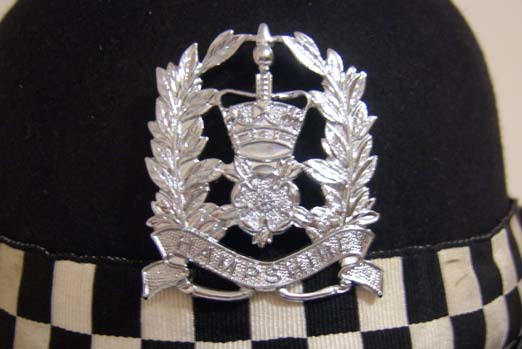 0
0 -
Hampshire Constabulary
The Hampshire Constabulary is situated in Southern England and serves Hampshire, the Isle of Wight and the cities of Portsmouth, Southampton and Winchester. Today's Hampshire Constabulary was formed in 1967 but its roots go back to 1832. Due to the Defence Regulations of 1943 the, then, Hampshire County Constabulary absorbed the Isle of Wight and Winchester to form the Hampshire Joint Police Force, in 1948 the name was changed to Hampshire Constabulary. Another name change occurred in 1952 and the Force became the Hampshire and Isle of Wight Constabulary.
With the addition of Southampton and Portsmouth under the Police Act of 1964 the Force became the current Hampshire Constabulary in 1967. This has remianed the same until present time, with the exception of Christchurch which became the policing responsibility of Dorset.
As may be seen in the photos below the custodian helmet plate differs greatly from the usual Brunswick Star used by many British police forces on their helmets.
Research material for this write up came from "Hampshire Constabulary, Wikipedia".
Regards
Brian
 0
0 -
This is what makes the GMIC invaluable to collectors.
I was not aware that the studs were darkened on the Metropolitan Police helmets. I just ran downstairs (in a panic) to check this out and I think I am alright with this helmet being genuine. When I looked at the helmet I noticed right off that the rear stud was dark yet the side and front studs were shinny. A closer look revealed that, due to wear, the dark finish had been worn off. There are still very small traces of this finish on the three studs.
This helmet came from a seller in America and I've purchased from him before with confidence. However, there seems to be many sellers who are throwing any helmet and plate together with no regard as to whether they belong to each other or not. There is one dealer in the UK, who I will not identify here to protect the GMIC from legal action, who is notorious for this. If any members are interested in this fellow's eBay name I will forward it to them but only through my email address. He mixes up the helmets and plates so often that I will not bid on anything he offers, no matter how genuine he may have made it look.
I wonder what "Dorset" is like this time of the year?

I will post the helmet in question in the British Headgear section with close up views for discussion later.
Thanks for your observastion and additional information on the helmets of the Metropolitan Police.
Regards
Brian
0 -
To wrap up this session I have included two Special Constabulary hat badges. I think we should include the Special's hat badges here as they deserve to be included and it will help this section to become a more complete reference source for helment plates and cap badges as time passes.
Regards
Brian
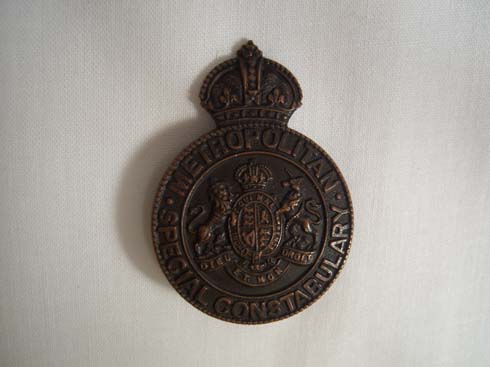
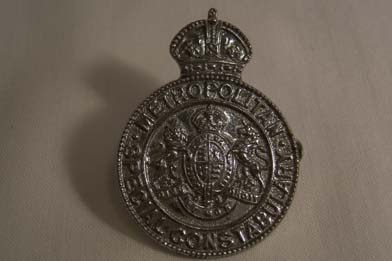 0
0 -
The counter piece to the one above is the plate for day duty. This is mounted on the custodian helmet and I will probably add the helmet to the British Police Headgear section if no one has beaten me to the punch with one of their own. ;)
 0
0 -
This is a specimen from the Queen Elizabeth II era, which is black for night duty.
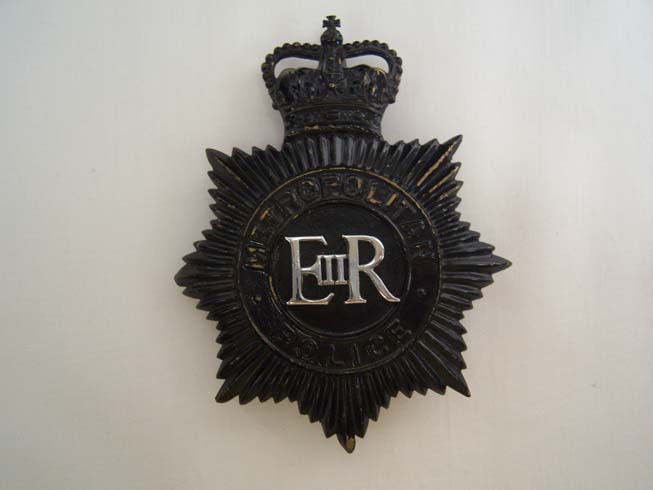 0
0 -
Here is the reverse of the chain and brooch. You can see the loops that went through the cape's material to fasten the lion's head to each side of the cape.
I am very happy with this piece and hope it was part of the set, though it probably wasn't.
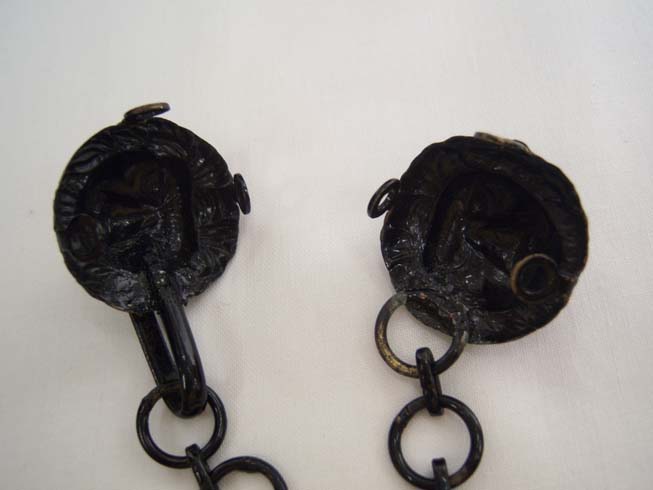 0
0 -
It would seem that I have forgotten to add the photo.
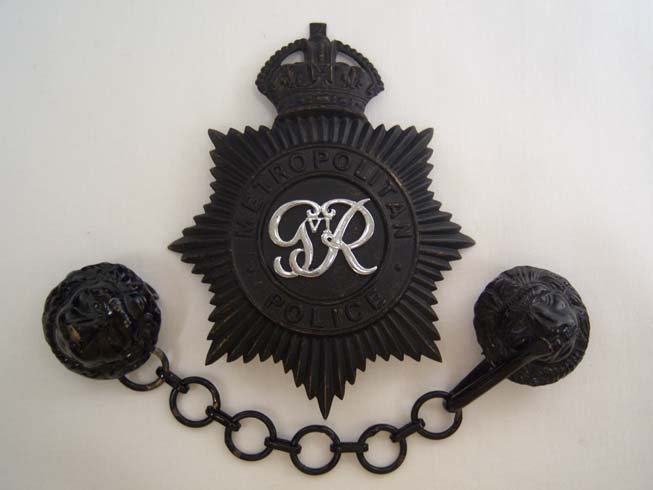 0
0 -
Hello Everyone,
I do hope others will add to this post and build it into a great reference for collectors and researchers, so please feel free to add your helmet plates and cap badges to this new theme.
It seems only fitting to kick this new theme off by starting with the first organized, modern, police force in the world, London's Metropolitan Police.
Founded in 1829 the force, stationed at the now iconic Scotland Yard, was founded by Sir Robert Peel in 1829 following a Parliamentary Commission Recommendation for policing changes in the previous year. It is interesting that the nicknames, "Peelers" and Bobbies" (named after the founder Sir Robert Peel) given to the new police force by a less than receptive public of the day has remained to the present time. Though the public's perceptions of the force and its officers has improved greatly in the eyes of the general public today [personal opinion].
My collection of British Police Helmet Plates and Cap Badges only goes back to King George VI, (I do hope others will help fill in the gaps), however, I have started this theme off with an example of a helmet plate from the King George VI era. I was lucky with the purchase of this specimen in picking up a period cape chain with brooches along with the plate.
Mervyn Mitton, in his book, "The Policemen's Lot", pg. 115, has the following to say about the cape chain. "The older capes were usually fastened by two lions' heads with a chain passing between and attaching to a hook behind one head. These were usually well cast and although some were painted black they are attractive enough to collect."
The Gentleman's Military Interest Club is quickly becoming a primary source of research and reference for the student and collector of British Police history and memorabilia. This is in no part possible without the continued participation of fellow members. Thank you to all who have contributed to the GMIC's British Police section and to those who will continue to help build what is becoming a world class forum. It is greatly appreciated.
My continued thanks goes out to Mervyn who kindly allows me to pirate ideas, research material and quotes from his book, and forgives my trespass when I forget to ask permission first.
Regards
Brian
0 -
Sorry Chris, I blame this on Stuart who is forever picking out such things in my emails to him.
I should have used the
 icon in my reply.
icon in my reply.Regards
Brian
0 -
These are great photos all on their own and I'm sure there will be many members who will look forward to your photos of the display from 30/31 July.
Needless to say that I will be among those eagerly awaiting those images.
Regards
Brian
0 -
Chris,
That is indeed a cool item.
I didn't know they used ink pens while in flight, I always assumed due to the rough ride of the aircraft of the day and extreme cold temperatures that they would have used a pencil.
Thanks for posting this, as you put it, "cool" item.

Regards
Brian
0 -
Brian,
gotcha! The painting by Lady Butler shows the 2nd (Royal North British) Regiment of Dragoons which was their designation from 1751 to 1866 in which year they became the 2nd (Royal North British) Dragoons (Royal Scots Greys).
Being heavy cavalry they were not part of the Charge of the Light Brigade and although the heavies were supposed to support the light cavalry they were not thrown away.
At last, something of substance I can add.
I used to own several horses and they are big dumb brutes. Get kicked by one or thrown and you will agree

Stuart
Well, it would seem the problem is in my writing. I meant that "horses" led the charge and not the Scots Greys. Sorry, one must be careful otherwise the message can become erroneous due to sentence structure.

The painting, I believe, has to do with the Battle of Waterloo.
Thanks for pointing that out.
Regards
Brian
0 -
The first photo was not as clear as I would have liked so here is a closer view of the helmet plate and the bowler hat badge.

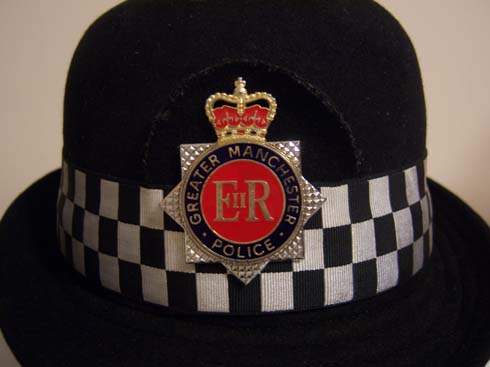 0
0 -
Hello Everyone,
Here's a nice pair that resides in my collection from The Greater Manchester Police.
A custodian's helmet and a WPC bowler.
Regards
Brian
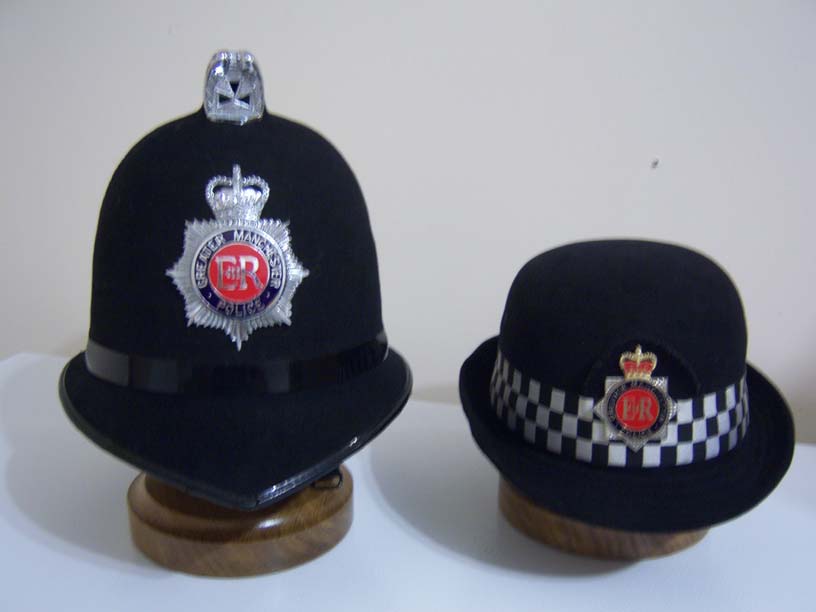 0
0 -
I am not sure that I would like to have a horse named "S"tuart
 or be named after such a beast!
or be named after such a beast!Stuart, the horse is such a noble beast. Check out the paintiing by Lady Elizabeth Butler of the Scots Greys at the Battle of Waterloo. They also led the charge of the light Brigade at Balaclava, ill fated as it was, the list goes on.
Better to have ones name associated with a majestic animal like a horse than a stubborn old mule (no inference intended).

I just know I'll pay for that one.

Regards
Brian
0 -
Brian,
I've already said it but what a terrific find. Now you need one with a King's crown

You said earlier that all police horses had a name beginning with the letter "S" but PC Roberts is riding Peel. Do you know when the change was made? I presume that the "S" is because it was Staffordshire.
Stuart
Yes the "S" was for Staffordshire but it was only the initial 50 that were given names that began with "S". I suppose that after 50 names it became harder to come up with them.

Good eye by the way, Stuart.
Regards
Brian
0




King George V.I. CD and 2 bars
in Commonwealth Realms: Canada, New Zealand & Australia Medals & Militaria
Posted
I agree with Frank, this is a very nice fine. This is the first two bar GVI CD I've seen as well.
Thanks for posting it.
Regards
Brian